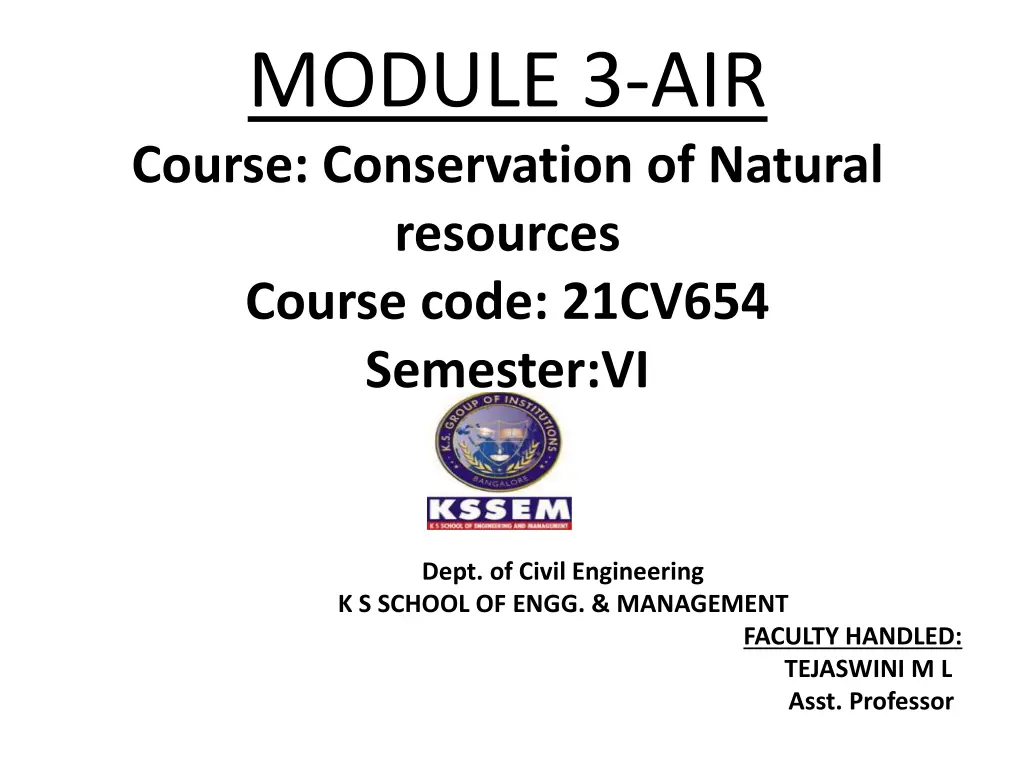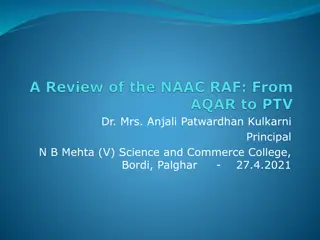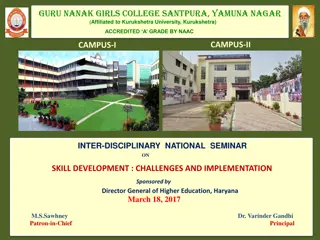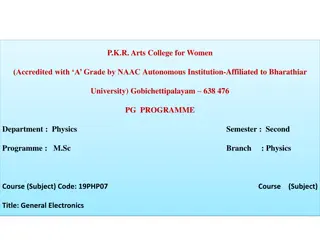
Understanding Air Pollution and Its Impact on the Environment
Explore the composition of air, types of pollutants, and classifications of air pollutants in this comprehensive course on Conservation of Natural Resources. Learn about the effects of air pollution on human health, economic impacts, and control measures to protect the environment.
Download Presentation

Please find below an Image/Link to download the presentation.
The content on the website is provided AS IS for your information and personal use only. It may not be sold, licensed, or shared on other websites without obtaining consent from the author. If you encounter any issues during the download, it is possible that the publisher has removed the file from their server.
You are allowed to download the files provided on this website for personal or commercial use, subject to the condition that they are used lawfully. All files are the property of their respective owners.
The content on the website is provided AS IS for your information and personal use only. It may not be sold, licensed, or shared on other websites without obtaining consent from the author.
E N D
Presentation Transcript
MODULE 3-AIR Course: Conservation of Natural resources Course code: 21CV654 Semester:VI Dept. of Civil Engineering K S SCHOOL OF ENGG. & MANAGEMENT FACULTY HANDLED: TEJASWINI M L Asst. Professor
SYLLABUS Introduction, composition, sources and classification of air pollutants, National Ambient Air quality standards (NAAQS), Air quality index, effects of air pollution on human health. Economic effects of air pollution. Control of air pollution by equipment, smoke and its control. Ozone depletion impacts, photochemical changes.
INTRODUCTION Air is the invisible mixture of gases that surrounds Earth. Air contains important substances, such as oxygen and nitrogen, that most species need to survive. The air is different as you move higher and higher into the atmosphere. The air gets "thinner" as elevation climbs because there are fewer air molecules up there.
Continuation. The composition of air refers to the chemical composition of the troposphere. The troposphere is the lowest layer of the atmosphere, extending from the surface to about 12 km or 39000 ft. The troposphere contains about 80% of the mass of the Earth s atmosphere. Nearly all of the atmosphere s water vapor exists in this layer. Just three gases account for 99% of dry air: nitrogen, oxygen, and argon.
Air Pollution and Pollutants Air pollution refers to any physical, chemical or biological change in the air. It is the contamination of air by harmful gases, dust and smoke which affects plants, animals and humans drastically. Pollutants - a substance something, especially atmosphere. that pollutes or water the
Continuation. Pollutants are substances or materials which impact the environment and its creatures thereby hampering the quality of life. There are various types of pollutants present in the environment which have negative effects on the environment.
Classifications of Pollutants According to origin
Continuation. According to state of matter
Sources of Air Pollution Stationary Sources A stationary source of air pollution refers to an emission source that does not move (i.e., power plants, chemical and manufacturing industries). Often stationary sources are defined as large emitters who release relatively consistent qualities and quantities of pollutants.
POINT SOURCE Point sources include- industrial and non industrial stationary equipment which are considered as significant sources of air pollution emissions. A facility is considered to have significant emissions if it emits about one ton or more in a calendar year.
Area Source The term AREA SOURCE is used to describe the many smaller stationary sources individual emissions may be low but whose collective emissions can be significant. Typically area sources are those that emit < 25 tons per year of any combination of hazardous air pollutants, or < 10 tons per year of any single hazardous air pollutant. Examples :- locomotives operating within a railyard Open burning and forest fires located together whose
NAAQS National (NAAQS) are standards for air quality that are set by the Central Pollution Control Board (CPCB) in the year 2009. The CPCB draws this power from the Air (Prevention and Control of Pollution) Act, 1981. This is applicable all over the country. Ambient Air Quality Standards
Continuation.. These standards are essential for the development of effective management of ambient air quality. The first ambient air quality standards were developed in 1982 pursuant to the Air Act. Later, in 1994 and 1998, these standards were revised. The latest revision to the NAAQS was done in 2009 and this is the latest version being followed. The 2009 standards further lowered the maximum permissible limits for pollutants and made the standards uniform across the nation. Previously, industrial zones had less stringent standards as compared to residential areas. The compliance of the NAAQS is monitored under the National Air Quality Monitoring Programme (NAMP). NAMP is implemented by the CPCB.
Continuation.. The current standards (2009) comprise 12 pollutants as follows : Particulate Matter 10 (PM10) Particulate Matter 2.5 (PM2.5) Nitrogen Dioxide (NO2) Sulphur Dioxide (SO2) Carbon Monoxide (CO) Ozone (O3) Ammonia (NH3) Lead (Pb) Benzene Benzopyrene Arsenic Nickel
Air Quality Index (AQI) The AQI was launched by the Prime Minister in April, 2015 starting with 14 cities and now extended to 71 cities in 17 states. The AQI is a tool for the effective communication of air quality status to people in terms, which are easy to understand. It transforms complex air quality data of various pollutants into a single number (index value), nomenclature and colour.
Continuation. There are six AQI categories, namely, good, satisfactory, moderately polluted, poor, very poor, and severe. The AQ sub-index and health breakpoints are evolved for eight pollutants (PM10, PM2.5, NO2, SO2, CO, O3, NH3, and Lead (Pb)) for which short-term (upto 24-hours) National Ambient Air Quality Standards are prescribed.
Effects of air pollution on human health 1. Tobacco smoke 2. Biological pollutants 3. Formaldehyde and Volatile organic compounds. 4. Lead. 5. Ozone and oxides of nitrogen 6. Carbon monoxide and Sulphur dioxide 7. SPM (suspended particulate matter).
Economic Effect of Air Pollution The projected increase in concentrations of PM2.5 and ozone will in turn lead to substantial effects on the economy. According to the calculations in this report, global air pollution- related healthcare costs are projected to increase from USD 21 billion in 2015 to USD 176 billion 2005 in 2060. The most dangerous consequences from outdoor air pollution are related to the number of premature deaths i.e., 3 million people in 2010 is estimated to 6-9 million annually in 2060.
Continuation.. The annual global welfare costs associated with the premature deaths from outdoor air pollution, calculated using estimates of the individual willingness-to pay to reduce the risk of premature death, are projected to rise from USD 3 trillion in 2015 to USD 18-25 trillion in 2060. In addition, the annual global welfare costs associated with pain and suffering from illness are projected to be around USD 2.2 trillion by 2060, up from around USD 300 billion in 2015, based on results from studies valuating the willingness to-pay to reduce health risks.
Air pollution control devices Air pollution control devices are a series of devices that work to prevent a variety of different pollutants, both gaseous and solid, from entering the atmosphere primarily smokestacks. These control devices can be separated into two broad categories - devices that control the amount of particulate matter escaping into the environment and devices that control acidic gas emissions. out ofindustrial
Continuation. Specific machinery is used to remove particulate matter from flue gases. Much of this separation uses physical means of separation and not chemical separation techniques simply because particulate matter is large enough to be "caught" in this manner. Below are some of the basic ways that particulate matter can be extracted. 1. Electrostatic Precipitators 2. Cyclone Separators 3. Fabric Filters
Electrostatic Precipitators A model of an electrostatic precipitator using metal wires as the negative electrodes and large plates as the positive electrodes
Continuation An electrostatic precipitator is a type of filter that uses static electricity to remove soot and ash from exhaust fumes before they exit the smokestacks. Unburned particles of carbon in smoke are pulled out of the smoke by using static electricity in the precipitators, leaving clean, hot air to escape the smokestacks. It is vital to remove this unreacted carbon from the smoke, as it can damage buildings and harm human health - especially respiratory health.
Continuation.. A cyclone separator is a separation device that uses the principle of inertia to remove particulate matter from flue gases. In these separators, dirty flue gas enters a chamber containing a vortex, similar to a tornado. Because of the difference in inertia of gas particles and larger particulate matter, the gas particles move up the cylinder while larger particles hit the inside wall and drop down. This separates the particulate matter from the flue gas, leaving cleaned flue gas.
Fabric filters A fabric filter is basically a porous substance. When the flue gas flows through it, those particles, which are larger than the pores, are collected. Collected ash particles form a deposit. This acts as an additional separation surface. The benefit of a fabric filter is that, metals, e.g., in the flue gas can deposit on collected dust.
Continuation.. Fabric filters used for controlling particulate matter operate like a vacuum cleaner. Dirty gas is blown or sucked through a fabric filter bag. The fabric bag collects the dust, which is removed periodically by shaking the bag. Fabric filters can be very efficient collectors for even submicrometer-sized particles and are widely used in industrial applications, although they may be sensitive to high temperatures and humidity.
Smoke and its control Gas Control More intense chemical methods of separation are generally required to separate polluting gases from the flue gas. However, this extraction is important as many acidic gases in flue gas contribute to acid rain. Below are some of the basic ways that gases can be extracted. 1. Scrubbers 2. Incineration 3. Carbon Capture
Scrubber Scrubbers are devices to control air pollution and used to remove some particulates and gases from industrial exhaust streams. Scrubbers are very efficient air pollution control devices, and can remove greater than 95 percent of the SO2from power plant stack emissions. In fact, SO2removal efficiencies sometimes are as high as 98 percent to 99 percent. Scrubbers with advanced designs routinely meet targeted efficiencies of more than 95 percent.
Continuation. Types of Scrubber The two main types of scrubbers are wet scrubbers and dry scrubbers. Wet Scrubbers Wet scrubbers force the polluted fumes to pass through a wet limestone slurry which traps sulfur particles. These can be used to control particulate matter less than 10 micrometers as well as inorganic gases such as SO2, H2S, NH3, and various chlorides and fluorides
Incineration Incineration is the destruction of something, especially waste material, by burning. Incineration is a waste treatment process that involves the combustion of organic substances contained in waste materials. Incineration of waste materials converts the waste into ash, flue gas and heat.
Carbon Capture Carbon dioxide can theoretically also be captured and stored underground or in forests and oceans to prevent it from entering the atmosphere. Carbon capture and storage refers to the process of capturing this carbon dioxide and storing it below ground, pumping it into geologic layers. This process is rarely being used.
Ozone-O3 Ozone is a gas present naturally within Earth s atmosphere. It is formed of three oxygen atoms (giving it the chemical formula O3). Its structure makes it unstable: it can be easily formed and broken down through interaction with other molecules. Ozone is most highly concentrated at two very different altitudes in the atmosphere: near the surface, and high in the atmosphere (in the stratosphere). Its function is very different in these two zones. with other compounds.
OZONE DEPLETION Ozone layer depletion is the gradual thinning of the earth s ozone layer in the upper atmosphere caused due to the release of chemical compounds containing gaseous bromine or chlorine from industries or other human activities.
Causes of Ozone Layer Depletion Ozone layer depletion is a major concern and is associated with a number of factors. The main causes responsible for the depletion of the ozone layer are listed below: Chlorofluorocarbons Chlorofluorocarbons or CFCs are the main cause of ozone layer depletion. These are released by solvents, spray aerosols, refrigerators, air-conditioners, etc. Unregulated Rocket Launches Researches say that the unregulated launching of rockets results in much more depletion of the ozone layer than the CFCs do. If not controlled, this might result in a huge loss of the ozone layer by the year 2050.
Continuation.. Nitrogenous Compounds The nitrogenous compounds such as NO2, NO, N2O are highly responsible for the depletion of the ozone layer. Natural Causes The ozone layer has been found to be depleted by certain natural processes such as Sun-spots and stratospheric winds. But it does not cause more than 1-2% of the ozone layer depletion.
Effects Of Ozone Layer Depletion Effects on Human Health Humans will be directly exposed to the harmful ultraviolet radiation of the sun due to the depletion of the ozone layer. This might result in serious health issues among humans, such as skin diseases, cancer, sunburns, cataract, quick ageing and weak immune system. Effects on Animals Direct exposure to ultraviolet radiations leads to skin and eye cancer in animals. Effects on the Environment Strong ultraviolet rays may lead to minimal growth, flowering and photosynthesis in plants. The forests also have to bear the harmful effects of the ultraviolet rays. Effects on Marine Life Planktons are greatly affected by the exposure to harmful ultraviolet rays. These are higher in the aquatic food chain. If the planktons are destroyed, the organisms present in the food chain are also affected.
USEFUL LINKS https://youtu.be/YhAwPFIUF_4?si=tCrPVLaomecJYjLI https://youtu.be/D55WLFHovMY?si=he0jJ4RKMkW5IyhJ https://youtu.be/PFV8PNnAHUU?si=ZLuYOZLURnYYb7jJ https://youtu.be/3R41hJwbLbc?si=38CHqspTtSVhwB1l





















